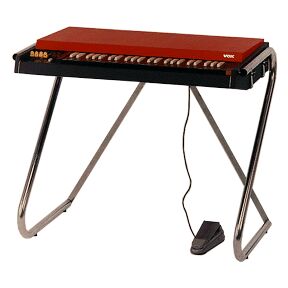
Vox: Single Manual Continentals
(I apologize for the size of this page. It's just exploded since I started it. Eventually, I'll split it up into multiple pages, but for now, just be patient and read the text while your browser loads all the images)
Controls:
Switches: Mains, Vibrato Off/On
Drawbars: 16' 8', 4', IV, "~", "M"
The IV drawbar is a mixture of four ranks: 2-2/3', 2', 1-3/5' and 1' (The Roman numeral "IV" indicates the number of footages included in the mixture) The "~" drawbar (aka "Foundation"), produces flute tones (it looks like a sine wave), and the "M" drawbar (aka "Reed") produces brighter tones (it looks like a sawtooth wave). If the ~ and M drawbars are all the way in, no sound at all comes out. Each of these two controls it's own voice in the footages selected by the other four drawbars. Example: If you have 16' and 8' all the way out, and all others in, you get nothing. If you pull the ~ drawbar out, you get 16' and 8' flute tones. If you pull the "M" drawbar out, it adds 16' and 8' reed tones. So the first four control the ranks, or pitches, and the last two control the timbre, or voice, of the selected ranks. Get it?
Vibrato Speed/Depth control modification Click in this link to go to a site with detailed instructions on adding speed and depth controls to an Italian Continental (the concepts would probably still hold for UK or US, but the hookup points may be different)
Original Prices:
The following prices have come from various sources, which I've documented briefly. They're probably so variable because of the differences between UK, US and Italian models, as well as declining demand as time went on. Of course, some were "list" prices, and some were "street" prices, which typically differ by as much as 30% or more. If you have any price lists, or clear recollections from way back when, I'd love to hear from you, and add to the pile.
1964-65 $999 (from The Vox Showroom)
1964-65 $995 (seen in a music store)
1966: $750 (price list)
1966-67 $450 (price quoted by Sam Ash salesman in Hempstead, LI)
1967 $799 (can't remember where I got this one from)
1968 $300 (seen at Lechemere's in MA)
1969 $795 (price list)
1970 $599 (can't rememer where I got this one from, either)
I've heard from various people that back then, salespeople would always steer potential organ customers toward Farfisas, and away from most everything else.
Design and Construction
I asked Derek Underdown to expound a bit on some of the design motives behind the Continental. Here's what he had to say:
"The intention was to achieve a Hammond sound in addition to typical theatre organ tones. The drawbars were intended to look and operate like the Hammond style. They had previously been used on our earlier theatre type organs, "J" series. I don't know of any other organ company that used this type of drawbar at that time. The reverse coloured keys were intentional to create a striking appearance and was influenced by the old spinet/harpsichord instruments."
Others have suggested just such a notion (that it was intended to emulate a Hammond), but I must say I was rather surprised to hear it "straight from the horse's mouth", so to speak. It does seem rather paradoxical that the Continental, designed to emulate/replace the Hammond organ, spawned a whole new genre of organ music, totally foreign to the typical Hammond sound, which eventually "matured" beyond the cheesy combo organ sound, and evolved into the classic Hammond/Leslie rock band combination (or "combo", heh, heh), eventually relegating the Continental and it's brethren to dusty attics and music shop back rooms barely 10 years after it's introduction. Of course, today (now that we've all come to our senses), it enjoys the same "vintage collectible" status as it's Hammond "nemesis".
Regarding the fixed, single-speed Vibrato:
"Vibrato was left at a fixed rate for space saving on the control surfaces and for simplicity. It is quite easy to convert it into a variable vibrato by adding a variable resistor into one of the arms of the "parallel-T" network, as we did with the theatre organs"
The Continental's filtering is a bit unusual. Instead of taking the raw square wave output from the oscillators, mixing them together and filtering at a global level, there are individual filters located at the output of each frequency divider, thus sending sawtooth waves to the keyboard. A further global filter is used after that to create the Foundation(flute) tones. Derek speaks briefly about the choice of waveforms:
"[The] foundation tone...needed to be a good Sine wave shape over the whole of the keyboard. The best way to get this was to convert the natural sawtooth waveform of the oscillators. This then gives you the standard (and only) Hammond sound. We gained the added advantage of being able to add in some or all of the sawtooth tones."
Regarding the target market:
"Many groups/rock bands in the UK were using the Hammond spinet two manual+pedal organs at that time. This instrument as you know is very heavy and not liked by the roadies when they had to move the bands equipment every night while on tour type gigs. It was our idea to use our technology to give the groups the Hammond sound but in lightweight/portable form."
Drawbar and contact assemblies:
"The actual drawbar assemblies were designed by myself in conjunction with the manufacturer Kimber and Allen Ltd,. Swanly, Kent. My contact there was a Mr. Milton. (now retired). This company also made all of the electrical contact assemblies which we modified from their standard pipe organ assemblies"
(Derek may have been referring to the Continental II, which he designed. According to Dave Linsell, Kimber-Allen also made the plastic keyboards used in the Continental II)
Many Continentals (single and double manual) have a tag with a name hand-written. I've seen or heard of a few that say "Jasmine". I'm sure there must have been others. Here's that Dave Linsell has to say about that:
"...the cable looms were made-up using 'pin-boards' in a psychiatric hospital (long-since closed) called Stone House, located about 1 mile to the east of the Vox/JMI Dartford factory in Stone, Kent...It was a horrible Victorian-style secure institution and we would visit from time-to-time to ensure things were being made properly etc. I don't know about the commercial arrangement, but I would guess that this 'sub-contract' set-up produced a high proportion of the looms used for keyboard-isolator interconnects...The cable looms, keyboards and isolator 'biscuits' were then assembled in Dartford or Erith, and that's probably where the 'Jasmine' tag originated - I didn't know her though."
Keyboards
According to Dave Linsell, the UK wooden keyboards were built by Herrburger Brooks
http://www.uk-piano.org/herrburgerbrooks/index.html
Optional Features
The first Continentals were offered with a Perspex (or Plexiglass, for those of us on the west side of the pond) music stand, which was an expensive, little-requested option. You can see it in some of the promo pictures below. Another optional feature was a Repeat Percussion. Derek Underdown does not remember fitting any Continentals with it, but concedes that some may have gone out as prototypes. This optional circuit (and a 5th set of key contacts used to trigger it) is shown on an early block diagram of the circuit, but there's no detail. And perhaps oddest of all, a 1964 catalog indicates that the Continental could be powered by either Mains (regular AC power) or batteries! Whoa! Derek confirmed that this idea was indeed considered, but he's fairly certain that, due to lack of customer interest, it was never actually implemented.
Model Variations
Since the Vox organ line was produced over so many years, by so many different companies, numerous variations have crept into the design. There are always going to be one-off's, aftermarket modifications, and other unexplained anomalies to be found, but I've attempted to document here the most common (and actual production) variations found.
Regarding model names, there are four major categories of models:
| Origin | Model Name(s) |
| UK: JMI | TC (a.k.a. "V301J") |
| US: Thomas | V301H |
| Italy: EME, GEM | V301E, V301E/2, V302E |
| UK: Vox Sound, Ltd. | STC |
All of the UK models I've seen have either "TC" in the model name, or else the space is blank (examples can be seen below). TC stood for "Transistor Continental" (no, there wasn't a corresponding "valve" version). The designation "V301J", used by some to refer to UK Continentals, was never (as far as I know) used by JMI, and never appeared on any UK ID badge or literature. It was used by Thomas Organ in their service literature to designate the UK models, with the "J" probably standing for "Jennings". The "E" in V301E may have stood for "EME", and the "H" in V301H stood, I'm told, for Hayvenhurst Ave., where the Thomas organ plant was located in Sepulveda, CA. I've seen what I believe was a Vox Sound Continental that had the model designation "STC", which, I presume, stood for "Silicon Transistor Continental".
ALL of the Italian Continentals were built by EME - nearly every one of the internal paper ID tags I've seen (the ones with the production dates stamped on them, found on virtually every Italian Vox organ) bears the name, both printed and signed, of either Tersino Ilari or Giuliano Claretti, both of whom were technicians at EME, responsible for the final testing of the organs. This fact has been confirmed by Terzino Ilari himself. Neither GEM nor JEN ever produced any Continentals. Only the Junior and one version of the Jaguar were made by GEM. JEN only made the Vox Piano and the "String Thing".
UK Version 1, aka "Square Top" (1962)
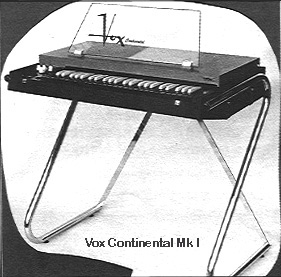 |
This promotional picture depicts the very earliest style of Continental, of which only about 100 were produced. The name "Square Top" was coined by fellow Combonaut, Micke L, and, for lack of a better designation, seems to have stuck. Note how the top is the same height front-to-back, and it's front edge is vertical rather than slanted. Compare this to the top design of later models (many shown further below). Note also that the top is shorter, front-to-back. The internals of this one are quite different than most you see, due to the more limited space inside. It also had a very different style mains/vibrato switch and pilot light. Read on... |
The "Square Top"
This version is quite rare. Many thanks to Stefan for supplying me with these pictures of his "Square Top"
And a few more shots of the "square top":
Here's what Derek Underdown has to say about the internal design of the early Continentals: "I don't have records of change dates for method of fixing the tone oscillators, however, the earlier Continentals had restricted room inside that limited methods of fitting the tone chassis. Soon after the first production batch of cases were sold the case and chassis fixing was modified to the more robust form you have seen on later models. There was probably not more than 100 or so of the first batch made. Circuitry remained substantially the same over the whole run."
and: "If I remember rightly this version had case dimensions that were a bit tight, so oscillator boards did not have room to be mounted onto metal plates as we did on our larger organs"
By "metal plates" I assume he's talking about those found on Version 2 (below)
UK Version 2 (1963)
UK Version 2.5 (early 1964)
UK Version 3 (mid-to-late 1964)
You can see more pictures of this Continental at David Egrefin's web site. Click on "Vox Continental I" (and check out his Compact Duo and Philicorda while you're there)
UK Version 4 (1965 and later)
UK Version 5 (date unknown)
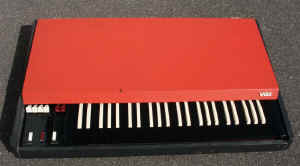 |
This one's really very much like Version 4
(above), The main outward
difference being the drawbars - they're white and red, more like the US
models. The internal layout of the circuit boards is also
somewhat different.
(Pictures of this one, courtesy of Ralph D. Sherman Click on the name to visit his web site - maybe he can help you out some time) |
Other than the drawbar colors, the main difference with this one is the internal design. Rather than the large metal power supply box found in previous versions, there is a transformer, and two circuit boards, for Vibrato and Power Supply circuitry, fixed to the left of the generator boards, much in the same manner as the Italian models.
UK Version 6 (date unknown - possibly 1967)
US-made Thomas, Model V301H (Early 1966)
Italian: Very early V301/E2 "single-point" (mid-1966)
Otherwise, it's pretty much like the other V301E/2's (below)
Italian V301E/2 (1966-1967)
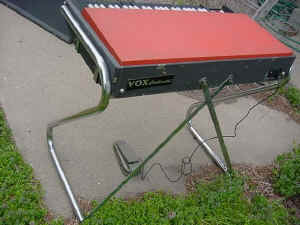
Rear view - crossed leg braces |
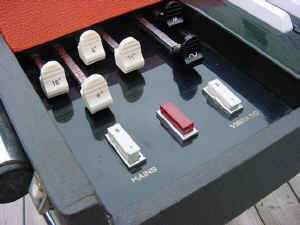
Control panel |
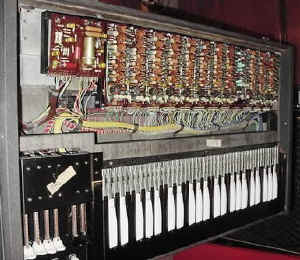
Internals |
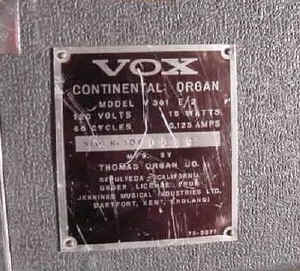
ID Badge - good view of the vinyl texture, too. |
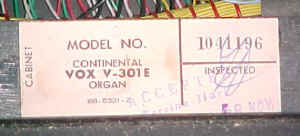 |
Internal paper ID tag |
Italian V302E (1967)
I've documented several examples of this model, and they all fit in neatly, date-wise, between the V301E/2's and the later V301E's - all from late '67 to early '68.
Sharp-eyed combonaut Micke Lindgren noticed that on the internal paper ID tags, the "0" following "105" has had a number "2" hand-written over it in red ink (you can see this in the example below). Every one I've followed up on has been like this.
Another interesting, but not terribly relevant detail: In the 1969 price list, the Stand/Case Combo appeared as model V302 (but was not priced separately)
Italian - V301E (1968)
Vox Sound, Ltd. (1970?)
Continental '71
Really just a basic Continental with a small bank of five Preset switches (looking very much like those on the Italian '300 or the Baroque). They function like Hammond presets (minus the "cancel" switch), with the first five "presetting" combinations of the four white drawbars (the drawbars themselves are deactivated), and the fifth activating the drawbars themselves. With a preset selected, the two sliders to the left of the keyboard determine the mix of Foundation and Reed tones. With the drawbars activated (preset #6), the black drawbars perform this function (like on a regular Continental).
Henry did a bit of experimenting, and determined that the presets are as follows:
PRESET 16' 8' 4' IV ----------------------------------- 1 8 0 8 0 2 8 0 0 8 3 0 8 8 0 4 8 4 3 1 5 1 3 4 8
6 (white drawbars)
After he found this rare bird, Henry and I were quite surprised to see not one, but TWO of them pop up on eBay within a few days of each other. (You can find ANYTHING on eBay, if you wait long enough). Funny thing is, all three (including Henry's) were located in the UK! (maybe they were trying to get back to their roots). In fact, I've seen no less than 10 Continental 71s, and every one of them was in the UK. I guess EME just shipped them all right back to Vox Sound, and never marketed any through Thomas or on their own.
Here's a manual (well, more of a "quick-reference" card): Many thanks to "Oz" for supplying me with scans:
And here, of all things, is a picture of one of these in action, with "The Brood", in January, 1993:
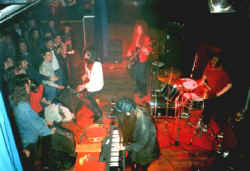
(Thanks to Micke for this one)
Norman's "Erith Prototype"
Serial Numbers/Dates
UK Models: I'm told that the very first Continental MK-I's had the number "119" embedded (I don't know exactly how - perhaps something like "11900" or "01191"). This came from the address of the factory, 119 Dartford Rd. I've not yet seen one so-numbered. I've observed three different number styles on the metal ID badges, and a fourth on a sticker found just behind the drawbar assembly. I'm not sure of the significance of the differences, nor if any conclusions can be drawn. I've only able to gather dates from a few UK models. Here's what I've found so far:
4-digit from metal ID badge:
1089 thru 4018
1089 Aug 1963 Version 1
21xx
Jan 1964 Version 2.5
1597 10/15/64 Version 3
1807 1/19/65
2912
3/14/66 Version 5
4018
Version 5
5-digit from metal ID badge:
01970 thru 02863
02192 8/23/65
5-digit on sticker behind
drawbars: 36840 thru 39363.
36840 6/10/65 Version 4
BD-3nnn, found on metal ID
badge: BD-3007 thru BD-3335
BD-3335 8/22/65 Version 4
BD-3686 Oct 1965 Version 4
JMI manufacture dates were kept in a factory log book, now long since lost.
US Models: These are more consistent, all beginning with "97", but as you can see, the numerical order doesn't seem to follow the date sequence. The dates on US models usually come from the left-most key. This may only indicate the manufacture date of the keyboard itself, which may bear no relation to that of the entire organ. I've seen numbers range from 970043 thru 970952.
The following are serial numbers for which I also have dates. The list is sorted numerically by serial number:
970043 04/12/66 970179 06/02/66 970214 04/01/66 970221 05/20/66 970310 04/25/66 970323 06/01/66 970382 06/14/66 970464 05/17/66 970650 03/09/66 970652 02/28/66 970920 06/15/66
Italian models: The V301E2 models all start with "104", and V301E's and V302E's start with "105", these digits being pre-printed on the metal id-badge. Each is followed by four unique digits, stamped on. On the V301E2's, the 4 digits start with "0" or "1", on V302E's, they start with "0", but are usually over-stamped (on the metal badge) or overwritten (on the paper tag) with a "2". V301E's start with a "3". The numerical order and date order seem to line up pretty consistently, as you can see below: The same serial number appears on a paper tag stapled to the inside.
Continental 71: I've seen or heard about ten specimens, with the following serials (No dates to be found on any of them).
3175023 3175052 3175084 3175095 3175117 (not real sure about this one) 3175128 3175140 3175176 3175755 3175952
Distinguishing characteristics
Different models can be identified by various means, some of which are presented here:
Leg Braces
|
|
English and US models have rear leg braces that meet at a single point on the back. |
Italian models cross (well, MOST of them, anyway) |
Which way should the little cutouts face? According to former Vox employee, Ron Lebar:
"The hook ends go at the top, with the open ends facing down, so they won't fall off if the screws are loose. When taking the legs off, some people leave the cross braces attached, swung parallel to the plane of the legs and the screws tightened. That way they won't get forgotten, or the screws lost."
Are the single-point and crossed braces different? NO! They're the same! So you can fit Italian braces on a UK or US Contientnal and vice-versa. In fact, the whole leg assembly is pretty much interchangeable between US, UK and Itlaian Continentals...and Jaguars! Only the thread pitch for the wingbolts is different.
Drawbar Tip Colors
Drawbar tip colors seem to be fairly consistent, and break down as follows:
UK Models(TC, aka "V301J"): Yellow and Red
(the latest models are more of a Cream/Red)
US Models (V301H): White and Red
Italian Models (V301E, V301E/2 and V302E): White and
Black
The shades of Yellow and Red tend to vary, with the Red often being more of a Maroon or Burgundy, but again, I'm relying on computer-based pictures so some may be illusion, some may be genuine variances.
Here's an excerpt from "Vox/Thomas Organ Service Bulletin No. 25", dated November 8, 1966 (thanks, Chris):
V301J:
Has Ivory colored drawbar knobs and wooden keyboard keys (sharp
keys have ivory colored plastic covering).
V301E: Has white drawbar knobs and plastic keyboard keys (sharp
keys are white plastic).
V301H: Has white drawbar knobs and wooden keyboard keys (sharp
keys \par are white colored plastic covering).
Rear Nameplates
I haven't yet drawn any conclusions about differences in nameplate styles. I'll just present a few examples for now.
Tone Generator boards
The last two English versions, the first Italian version, and the US version are all documented in a 1966 Thomas Organ service bulletin The Italian board, while somewhat different in appearance, is fully interchangeable with the Version 4 English board. The USA and "Vox Sound" boards are substantially different, and are incompatible with the other three (and each other).
I've seen a few different schematics of Continentals, both UK and Italian in origin, and they're all pretty much identical There were some very minor changes made early on, around 1963, that involved the addition of a couple of resistors to the divider circuits, but other than that, the circuitry remained largely un-changed. I've heard a few people say they can hear the difference between a UK and an Italian model. I've many others say that there's no difference at all. I can't say from personal experience, because I've never heard a side-by-side comparison, but I imagine it would be a fairly subtle difference, probably due more to aging components than to any minor circuit or component differences.
It's often presumed that the use or Germanium versus Silicon transistors will have an effect on the sound. I've heard from several knowledgeable technical folks who are certain that this is NOT the case. The US Continental uses Silicon transistors, while UK and Italian models use Germanium. I'm told there is no perceptible difference between the two. The use of transistors in organ tone generators is very different from their use in fuzzboxes (where the type of transistor DOES make a difference). It's even possible to substitute Silicon transistors for Germanium ones, and no change in sound will be noticed. Organ dividers (which generate all the lower octaves from the top octave oscillators) are basically just switching circuits, each creating a square wave output at half the frequency of whatever input signal is applied. Square waves produced by Silicon transistors look and sound the same as those produced by Germanium. The key to organ voicing is found in the filters, which typically don't use any transistors at all!
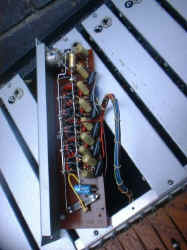
English - Version 1, 2 and 2.5 |
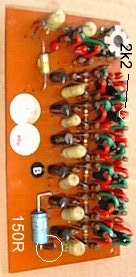
English - Version 3 |
  English - Version 4, 5 and 6, the most common type. Two different specimens shown. |
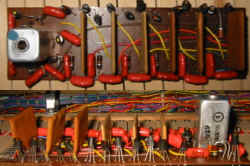
USA |

Italian |

"Vox Sound" Italian model |
Coverings
The first batch of 100 or so MKI Continentals had the "square top", covered in orange Rexine. Red was introduced later, and UK organs were made with both Red and Orange tops. Some may argue that ALL Continental tops are orange. Having to rely largely on computer-based pictures, I could not argue this point convincingly one way or the other.
Supposedly, a small number of very early Continentals were covered in Red and Blue, to match AC30 amps of the same color. I've heard of the existence of AC30's in those colors, but have not yet heard of a Continental so colored.
As with most other Vox organ characteristics, a number of different types, shades and textures were used over the years. There are two terms used for the covering, "Rexine" and "Vinyde". Here's the best I've been able to come up with:
Rexine (a.k.a. "leathercloth", rather a generic term for a textured vinyl covering) was used to cover Continental tops, and came in orange, red and grey (grey being used on UK Continental II's). It was made by ICI in the 60's, and the brand name has since been taken over by F.J. Ratchford, Ltd., which sells it as a book covering material. Rexine was (and still is) used to cover books, car dashboards, drink coasters and loads of other things. Henry tells me that Ratchford supplies a very good red and grey, but not in the "classic" UK pattern, and also a very good Italian style in red and black but not burnt orange. The original embossing rollers used by ICI were taken over by Wardle Storeys, which supply Ratchford with their coverings. Unfortunately, the roller used to emboss the original UK-style Rexine was not taken, and has probably been lost. Henry supplied me a few samples of different coverings:
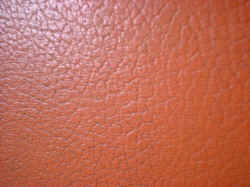
The "Classic Orange" Rexine |
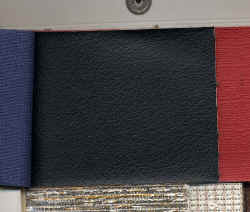
"Smooth Tolex" - from a 1965 swatch book |
Grey Rexine, also from the 1965 swatch book |
Vinyde: Also a branded product produced by ICI I'm not sure how this name fits in; if some organs were covered in Rexine, and some in Vinyde, or a combination of the two.
Tolex: Tolex is actually a US brand name, and was used on Fender amps, among others. It's sort of degenerated into a generic term for any textured vinyl covering, especially when referring to amp coverings. early UK Continental coverings are often called "smooth tolex".
Dark covering examples